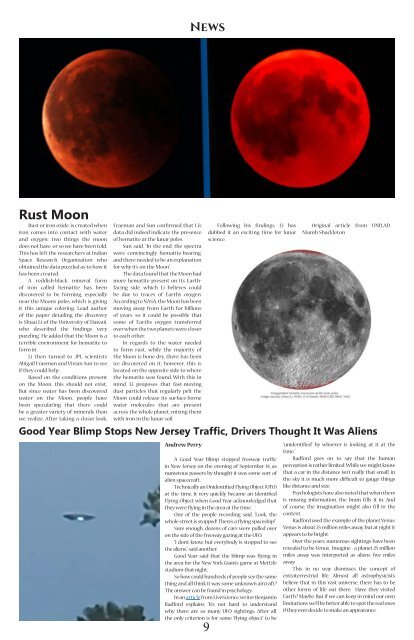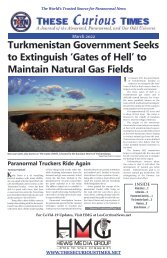September/October 2020 - These Curious Times
In this special 16-page issue, we cover things to do during Halloween while the pandemic still grips the world, mediums, a documentary about one of the world's longest ongoing paranormal investigations, and a special editorial page geared towards this year's election and the sincere hope that ideas can be discussed, protests can be had, and elections can happen, without the threat of violence.
In this special 16-page issue, we cover things to do during Halloween while the pandemic still grips the world, mediums, a documentary about one of the world's longest ongoing paranormal investigations, and a special editorial page geared towards this year's election and the sincere hope that ideas can be discussed, protests can be had, and elections can happen, without the threat of violence.
Create successful ePaper yourself
Turn your PDF publications into a flip-book with our unique Google optimized e-Paper software.
News<br />
Rust Moon<br />
Rust or iron oxide, is created when<br />
iron comes into contact with water<br />
and oxygen; two things the moon<br />
does not have, or so we have been told.<br />
This has left the researchers at Indian<br />
Space Research Organization who<br />
obtained the data puzzled as to how it<br />
has been created.<br />
A reddish-black mineral form<br />
of iron called hematite has been<br />
discovered to be forming, especially<br />
near the Moon’s poles, which is giving<br />
it this unique coloring. Lead author<br />
of the paper detailing the discovery<br />
is Shuai Li of the University of Hawaii,<br />
who described the findings ‘very<br />
puzzling’. He added that ‘the Moon is a<br />
terrible environment for hematite to<br />
form in’.<br />
Li then turned to JPL scientists<br />
Abigail Fraeman and Vivian Sun to see<br />
if they could help.<br />
Based on the conditions present<br />
on the Moon, this should not exist.<br />
But since water has been discovered<br />
water on the Moon, people have<br />
been speculating that there could<br />
be a greater variety of minerals than<br />
we realize. After taking a closer look,<br />
Fraeman and Sun confirmed that Li’s<br />
data did indeed indicate the presence<br />
of hematite at the lunar poles.<br />
Sun said, “In the end, the spectra<br />
were convincingly hematite-bearing,<br />
and there needed to be an explanation<br />
for why it’s on the Moon”.<br />
The data found that the Moon had<br />
more hematite present on its Earthfacing<br />
side, which Li believes could<br />
be due to traces of Earth’s oxygen.<br />
According to NASA, the Moon has been<br />
moving away from Earth for billions<br />
of years, so it could be possible that<br />
some of Earth’s oxygen transferred<br />
over when the two planets were closer<br />
to each other.<br />
In regards to the water needed<br />
to form rust, while the majority of<br />
the Moon is bone dry, there has been<br />
ice discovered on it; however, this is<br />
located on the opposite side to where<br />
the hematite was found. With this in<br />
mind, Li proposes that fast-moving<br />
dust particles that regularly pelt the<br />
Moon could release its surface-borne<br />
water molecules that are present<br />
across the whole planet, mixing them<br />
with iron in the lunar soil.<br />
9<br />
Following his findings, Li has<br />
dubbed it an exciting time for lunar<br />
science.<br />
Original article from UNILAD.<br />
Niamh Shackleton<br />
Good Year Blimp Stops New Jersey Traffic, Drivers Thought It Was Aliens<br />
Andrew Perry<br />
A Good Year blimp stopped freeway traffic<br />
in New Jersey on the evening of <strong>September</strong> 14, as<br />
numerous passers by thought it was some sort of<br />
alien spacecraft.<br />
Technically an Unidentified Flying Object (UFO)<br />
at the time, it very quickly became an Identified<br />
Flying Object when Good Year acknowledged that<br />
they were flying in the area at the time.<br />
One of the people recording said, “Look, the<br />
whole street is stopped! There’s a flying spaceship!”<br />
Sure enough, dozens of cars were pulled over<br />
on the side of the freeway gazing at the UFO.<br />
“I don’t know, but everybody is stopped to see<br />
the aliens,” said another.<br />
Good Year said that the blimp was flying in<br />
the area for the New York Giants game at MetLife<br />
stadium that night.<br />
So how could hundreds of people see the same<br />
thing and all think it was some unknown aircraft?<br />
The answer can be found in psychology.<br />
In an article from LiveScience, writer Benjamin<br />
Radford explains, “It’s not hard to understand<br />
why there are so many UFO sightings. After all,<br />
the only criterion is for some “flying object” to be<br />
“unidentified” by whoever is looking at it at the<br />
time.”<br />
Radford goes on to say that the human<br />
perception is rather limited. While we might know<br />
that a car in the distance isn’t really that small, in<br />
the sky it is much more difficult to gauge things<br />
like distance and size.<br />
Psychologists have also noted that when there<br />
is missing information, the brain fills it in. And<br />
of course, the imagination might also fill in the<br />
context.<br />
Radford used the example of the planet Venus.<br />
Venus is about 25 million miles away, but at night it<br />
appears to be bright.<br />
Over the years, numerous sightings have been<br />
revealed to be Venus. Imagine - a planet 25 million<br />
miles away was interpreted as aliens five miles<br />
away.<br />
This in no way dismisses the concept of<br />
extraterrestrial life. Almost all astrophysicists<br />
believe that in this vast universe, there has to be<br />
other forms of life out there. Have they visited<br />
Earth? Maybe. But if we can keep in mind our own<br />
limitations, we’ll be better able to spot the real ones<br />
if they ever decide to make an appearance.









